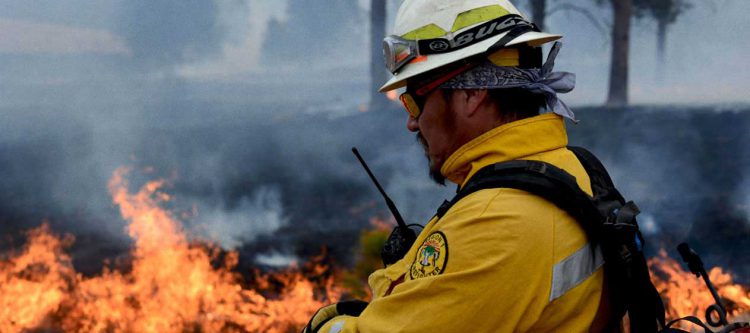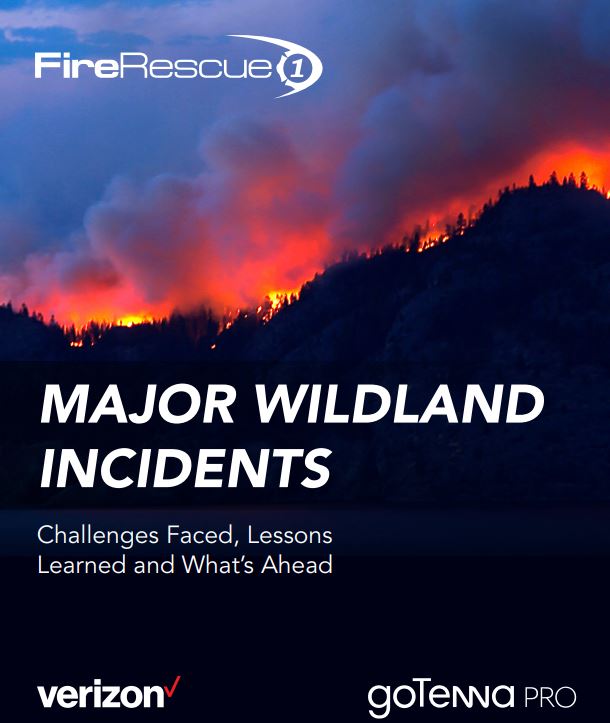Denied in the heat of battle – why traditional radios fall short when battling a wildfire

The summer and fall months are peak wildfire season thanks to a combination of warm, dry weather, low precipitation and high winds. And these months are incredibly important for firefighters and emergency response organizations across the Midwest and the Pacific Northwest because of a wildfire’s sheer destructive potential.
Just last year, wildfires accounted for more than $400 billion in economic losses in California alone. That same year, California spent more than $1 billion fighting wildfires. And those numbers will only increase in the future with record high temperatures and climate change threatening to make wildfires more frequent and more intense.
As a former firefighter, I recognize the danger and challenge that wildfires create for first responders and emergency personnel. While I’ve been trained and work mostly in response to structure fires, I have had to participate in the battle against multiple brush and grass fires and have trained to battle wildfires. And I can say, with certainty, that the situations and challenges that firefighters face when fighting them are complex and unique.
Let’s take a look at some of the ways responding to a wildfire is unlike responding to any other emergency situation, and some of the unique communications and situational awareness challenges that wildfires create.
Unpredictable, immense and constantly changing
Wildfires are expansive. They are, as a definition, huge. But, unlike other large, lumbering things, wildfires move quickly. You would be surprised by just how quickly they can spread.
The sheer size and speed of a wildfire means more coordination and cooperation is required. When a fire is threatening multiple towns or municipalities at once, all of them have to spring into action and work together in the fight. This can create its own challenges, since firefighters and first responders from different municipalities may not always train together and may not have the ability to communicate — which is essential to collaboration and cooperation in disaster situations.
At the same time, wildfires are also unpredictable. Individuals who may have thought they were in a safe location may suddenly find themselves in harm’s way. This means that knowing and understanding a fire’s movement and location is incredibly essential. This also makes it important for dispatchers and command to know where their personnel are at all times.
Finally, wildfires are destructive. And they don’t just destroy people’s homes and belongings. One of the things that wildfires also destroy is critical infrastructure. Whether it’s cellular towers or radio relay towers, necessary infrastructure — including communications infrastructure — is often an early casualty of a fire.
When combined together, the speed, unpredictability and destructive power of a wildfire can wreak havoc on the communications systems of first responders.

Stretched, stressed, and broken
For a number of years, I served as a police dispatcher in Grand Rapids, MI, where I heard firsthand how emergency response situations could stress and stretch the traditional voice radio networks employed by first responders.
Traditional voice radios are a centralized network comprised of small, 5 watt handheld transmitters and receivers that reach out to very large, 100 watt, retransmit stations. These retransmit stations are very much stationary — they’re the large towers with generators at the bottom that we’ve all seen and passed by on hikes through the forest. These retransmit stations are set up in advance and are set up in such a fashion so that the hand radios being used by that jurisdiction will retransmit the signal.
This setup with traditional voice radios has worked for decades, but not without challenges. And wildfires can rapidly add to those.
A traditional voice radio setup favors the more powerful signal. That means that the person closest to the other radios and retransmit stations is likely the one that is heard. With older analog radios, the stronger signal would simply win out, and only that one would be heard. With newer digital radios, both are transmitted simultaneously, creating a jumbled mess and situation where neither message gets through.
With wildfires covering so much ground and requiring such a large response, it becomes really problematic when there is competition between individuals trying to get essential messages through. And with wildfires changing direction and moving so quickly, this goes beyond damaging the ability to coordinate; it can be downright deadly to firefighters if their message of alarm or requests for help can’t be heard.
Then there’s the issue with the retransmit stations. As I discussed previously, they can be easily destroyed by wildfires and they’re not easily replaced since they are large, stationary units. What’s worse, they’re often set up to only work with a local municipality’s signal or channel to help fight against interference and keep unwanted messages from being retransmitted. This creates problems when multiple towns or counties have to respond and work together to fight a blaze.
Ultimately, traditional voice radio systems are easily stretched, stressed, and broken in wildfire situations — leaving first responders at risk and making cooperation and communication difficult. But there is another way.
Mobile mesh networking and wildfires
With mobile mesh networking, you’re no longer relying on a centralized rely station. Instead, each individual mesh network node is retransmitting the signal. This means that there is no one single point of failure, no one large piece of infrastructure or hardware that can be destroyed and, subsequently, deny all communications.
Mobile mesh networking also adds additional functionality and capabilities. Since today’s small-format, mobile mesh networking nodes connect to smart devices either via Bluetooth or USB, they benefit from the added capabilities of that smart device.
Every smartphone that leaves a factory these days has an installed GPS receiver built into it. This receiver functions independently of the cellular network, so users can see themselves on a map regardless of whether they’re connected or not. Utilizing downloaded maps and situational awareness applications — such as ATAK — firefighters can see detailed maps on smartphones even if the cellular network is denied or flooded. This location can then be shared with others and displayed on their maps — meaning a firefighter’s location can be shared and mapped on all other firefighters’ devices.
Mobile mesh networking not only helps to decentralize the critical infrastructure for communications, but also adds mapping, situational awareness and other functionality that can help keep first responders and firefighters safer and better connected.
While I don’t believe that mobile mesh networks will fully replace the voice radio in wildfire response, it really is a complementary solution that can make the voice radio more functional in these situations. Mobile mesh networking can take much of the load off of voice radio networks and make the use of voice radios by multiple jurisdictions and municipalities go from terrifying to acceptable.
In my next article on the Last Mile, I’ll look at how network connectivity can make mobile mesh networking even more capable, and how recent code and regulation changes could better equip firefighters for wildfire response in the future. If you’d like to learn more about the role that mobile mesh networking can play in fighting wildfires, click HERE for a complimentary copy of the eBook, “Major wildland incidents.“








No Comment